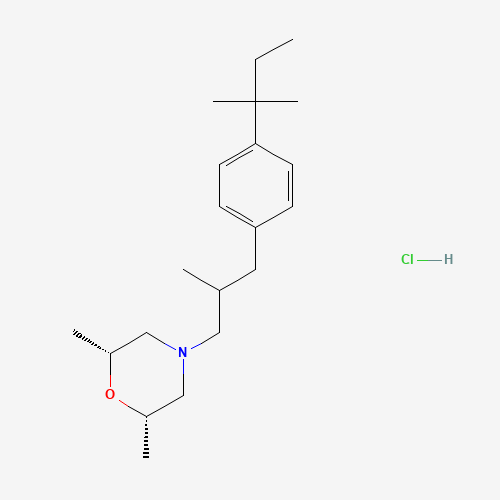| Pharmaceutical Information |
| Drug Name |
Amorolfine hydrochloride |
| Drug ID |
BADD_D00127 |
| Description |
Amorolfine or amorolfin, is a morpholine antifungal drug that inhibits the fungal enzymes D14 reductase and D7-D8 isomerase. This inhibition affects fungal sterol synthesis pathways, depleting ergosterol and causing ignosterol to accumulate in the fungal cytoplasmic cell membranes. Amorolfine is marketed as Curanail, Loceryl, Locetar, and Odenil. It is available in the form of a 5% amorolfine nail lacquer used to treat onychomycosis (fungal infection of the toe- and fingernails). Amorolfine 5% nail lacquer in once or twice weekly applications is 60-71% effective in treating toenail onychomycosis; complete cure rates three months after stopping treatment (after six months of treatment) were 38-46%. However, full experimental details of these trials were not available and since they were first reported in 1992 there have been no subsequent trials.
It is a topical solution for the treatment of toenail infections. Systemic treatments may be considered more effective.
It is approved for sale over the counter in Australia and the UK (recently re-classified to over the counter status), and is approved for the treatment of toenail fungus by prescription in other countries. It is not approved for the treatment of onychomycosis in the United States or Canada. |
| Indications and Usage |
Not Available |
| Marketing Status |
approved; investigational |
| ATC Code |
D01AE16 |
| DrugBank ID |
DB09056
|
| KEGG ID |
D01720
|
| MeSH ID |
C038974
|
| PubChem ID |
54259
|
| TTD Drug ID |
D0QC3M
|
| NDC Product Code |
Not Available |
| UNII |
741YH7379H
|
| Synonyms |
amorolfine | Loceryl | Locéryl | Locetar | Ro 14-4767-002 | Ro-14-4767-002 | amorolfin hydrochloride | amorolfine hydrochloride | Odenil |
|
| Chemical Information |
| Molecular Formula |
C21H36ClNO |
| CAS Registry Number |
78613-38-4 |
| SMILES |
CCC(C)(C)C1=CC=C(C=C1)CC(C)CN2CC(OC(C2)C)C.Cl |
| Chemical Structure |

|
|
| ADRs Induced by Drug |
|
|
*The priority for ADR severity classification is based on FAERS assessment, followed by the most severe level in CTCAE rating. If neither is available, it will be displayed as 'Not available'.
**The 'Not Available' level is hidden by default and can be restored by clicking on the legend twice..
|
|
|

